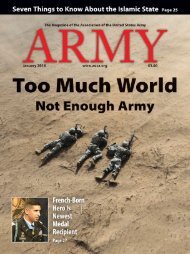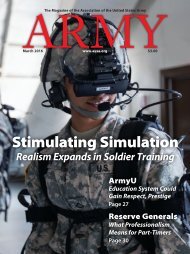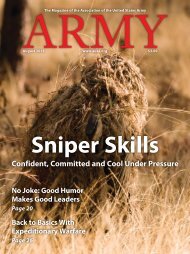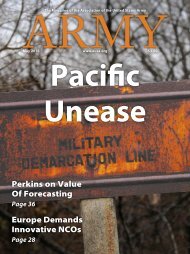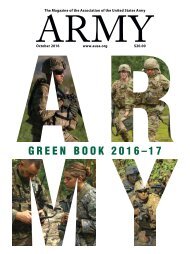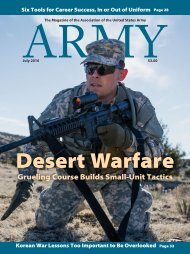Army - Kicking Tires On Jltv
You also want an ePaper? Increase the reach of your titles
YUMPU automatically turns print PDFs into web optimized ePapers that Google loves.
Creativity<br />
Could Boost<br />
Regionally Aligned<br />
Forces Concept<br />
By Col. Allen J. Pepper<br />
A 12th Combat Aviation Brigade AH-64D Apache Longbow helicopter flies over Grafenwoehr Training Area, Germany.<br />
U.S. <strong>Army</strong>/Gertrud Zach<br />
<strong>Army</strong> leadership’s vision involves a force that is globally<br />
responsive and regionally engaged. An important<br />
aspect of turning this vision into reality is the concept<br />
of regionally aligned forces. This concept, which the<br />
<strong>Army</strong> has been executing since early 2013, provided U.S. Africa<br />
Command with trained and available forces for a range of missions;<br />
supported U.S. Pacific Command in the pivot to the Pacific;<br />
and enabled a rapid response by U.S. European Command<br />
and NATO to Russian aggression in Ukraine.<br />
Despite these early successes and other recent accomplishments,<br />
the concept of regionally aligned forces (RAF) leaves<br />
room for improvement to foster the development of soldiers<br />
and leaders for future <strong>Army</strong> readiness and thereby support geographic<br />
combatant commands. In particular, the <strong>Army</strong> must<br />
work creatively to find opportunities to deploy these units into<br />
their theaters, improve continuity between RAF rotations, include<br />
regional affiliation in officer and NCO assignment decisions,<br />
and select promising junior and midlevel leaders for regular<br />
small-unit missions within the RAF construct.<br />
The concept of regionally aligned forces involves aligning<br />
select units from both the active and reserve components of<br />
the <strong>Army</strong> to the geographic combatant commands. As highlighted<br />
in a September 2014 briefing from the <strong>Army</strong> Staff,<br />
these units and soldiers should develop enhanced situational<br />
understanding of their designated region and increase their<br />
readiness for serving through on-the-job training and active<br />
engagement. Improved situational awareness will help make<br />
them better partners for both the U.S. interagency and allies.<br />
RAF units are primarily involved in activities to shape the operational<br />
environment, with an emphasis on building relationships<br />
as well as partner capacity. However, the deployment of<br />
part of an infantry company to protect the U.S. Embassy in<br />
South Sudan for five months in 2013–14 showed that RAF units<br />
are not strictly limited to shaping the operational environment.<br />
Start With Decisive Action Training<br />
The training pipeline for the brigade combat team around<br />
which each geographic combatant command’s RAF is built<br />
starts with decisive action training, including a combat training<br />
center rotation, resources permitting. This is augmented with<br />
geographic combatant command-specific training requirements<br />
and cultural, regional expertise and language training.<br />
The <strong>Army</strong> intends for the RAF concept to provide benefits<br />
to combatant commanders, soldiers and units. U.S. Africa<br />
Command, the test-bed geographic combatant command for<br />
regionally aligned forces, saw stark improvements in the availability<br />
of trained troops for security cooperation activities with<br />
the implementation of the RAF concept. The European Command<br />
has also benefited from the assured availability of <strong>Army</strong><br />
forces, as the U.S. has provided a portion of a brigade combat<br />
team to the NATO Response Force for the first time since that<br />
force’s inception in 2003. That same brigade combat team—<br />
the 1st Brigade, 1st Cavalry Division—also participated in the<br />
NATO exercise Combined Resolve II, and assured regional<br />
partners with U.S. presence in Poland and the Baltics as part of<br />
the NATO response to Russian aggression in Ukraine.<br />
32 ARMY ■ February 2016




